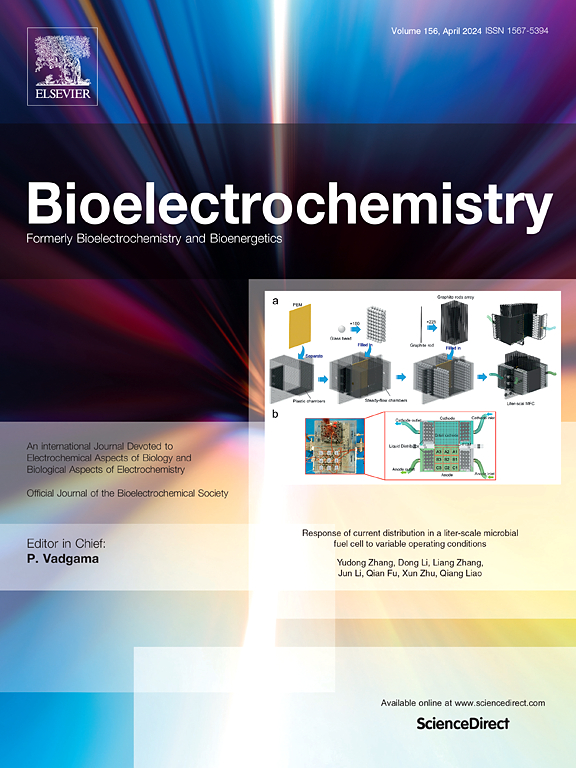Emerging screening platform characterises aminoquinoline structure–activity relationships with phospholipid layers
IF 4.8
2区 化学
Q1 BIOCHEMISTRY & MOLECULAR BIOLOGY
引用次数: 0
Abstract
Aminoquinolines (AQ) and substituted aminoquinolines (s-AQ) interact with electrochemically monitored supported dioleoyl phosphatidylcholine (DOPC) monolayers and immobilised artificial membranes (IAM) on HPLC column. The electrochemical sensor records adsorption/partition of the compound on and into the layer as well as specific interactions due to the location of the compound in the layer. HPLC-IAM technology measures the partition coefficient between the solution and phospholipid including partition due to interaction of the positive molecular charge with the phospholipid polar heads. The monolayer interaction results were combined and normalised for the neutral compounds’ lipophilicity as a log biomembrane affinity index (‘log BAI’) to exemplify charge and structural features in the interaction. A ChimeraX molecular modelling procedure was used to aid in the results interpretation. A compound ToxScore value was derived from 5 in vitro assays. The ‘log BAI’ exhibited a linear relationship with the AQ pKa values showing that the interaction was related to the molecular positive charge and to the electron donating properties of the –NH2 group. The correlation outliers showed a tendency/no tendency to H-bonding with the polar groups and a superficial/deeper location respectively in the phospholipid layer. The s-AQ ‘log BAI’ value displayed a power correlation with the compounds’ ToxScore values.

新兴的筛选平台表征氨基喹啉与磷脂层的构效关系
氨基喹啉(AQ)和取代氨基喹啉(s-AQ)与高效液相色谱柱上的电化学监测支撑二油酰磷脂酰胆碱(DOPC)单层和固定人工膜(IAM)相互作用。电化学传感器记录化合物在层上和层中的吸附/分离情况,以及化合物在层中的位置所导致的特定相互作用。HPLC-IAM 技术测量溶液与磷脂之间的分配系数,包括正分子电荷与磷脂极性头相互作用产生的分配。结合单层相互作用结果,并根据中性化合物的亲脂性将其归一化为生物膜亲和指数对数("log BAI"),以体现相互作用中的电荷和结构特征。ChimeraX 分子建模程序用于帮助解释结果。从 5 项体外检测中得出了化合物 ToxScore 值。对数 BAI "与 AQ pKa 值呈线性关系,表明相互作用与分子正电荷和 -NH2 基团的电子捐赠特性有关。相关离群值分别显示了与极性基团的 H 键作用倾向/无倾向,以及在磷脂层中的浅层/深层位置。s-AQ 的 "对数 BAI "值与化合物的 ToxScore 值呈幂相关性。
本文章由计算机程序翻译,如有差异,请以英文原文为准。
求助全文
约1分钟内获得全文
求助全文
来源期刊

Bioelectrochemistry
生物-电化学
CiteScore
9.10
自引率
6.00%
发文量
238
审稿时长
38 days
期刊介绍:
An International Journal Devoted to Electrochemical Aspects of Biology and Biological Aspects of Electrochemistry
Bioelectrochemistry is an international journal devoted to electrochemical principles in biology and biological aspects of electrochemistry. It publishes experimental and theoretical papers dealing with the electrochemical aspects of:
• Electrified interfaces (electric double layers, adsorption, electron transfer, protein electrochemistry, basic principles of biosensors, biosensor interfaces and bio-nanosensor design and construction.
• Electric and magnetic field effects (field-dependent processes, field interactions with molecules, intramolecular field effects, sensory systems for electric and magnetic fields, molecular and cellular mechanisms)
• Bioenergetics and signal transduction (energy conversion, photosynthetic and visual membranes)
• Biomembranes and model membranes (thermodynamics and mechanics, membrane transport, electroporation, fusion and insertion)
• Electrochemical applications in medicine and biotechnology (drug delivery and gene transfer to cells and tissues, iontophoresis, skin electroporation, injury and repair).
• Organization and use of arrays in-vitro and in-vivo, including as part of feedback control.
• Electrochemical interrogation of biofilms as generated by microorganisms and tissue reaction associated with medical implants.
 求助内容:
求助内容: 应助结果提醒方式:
应助结果提醒方式:


